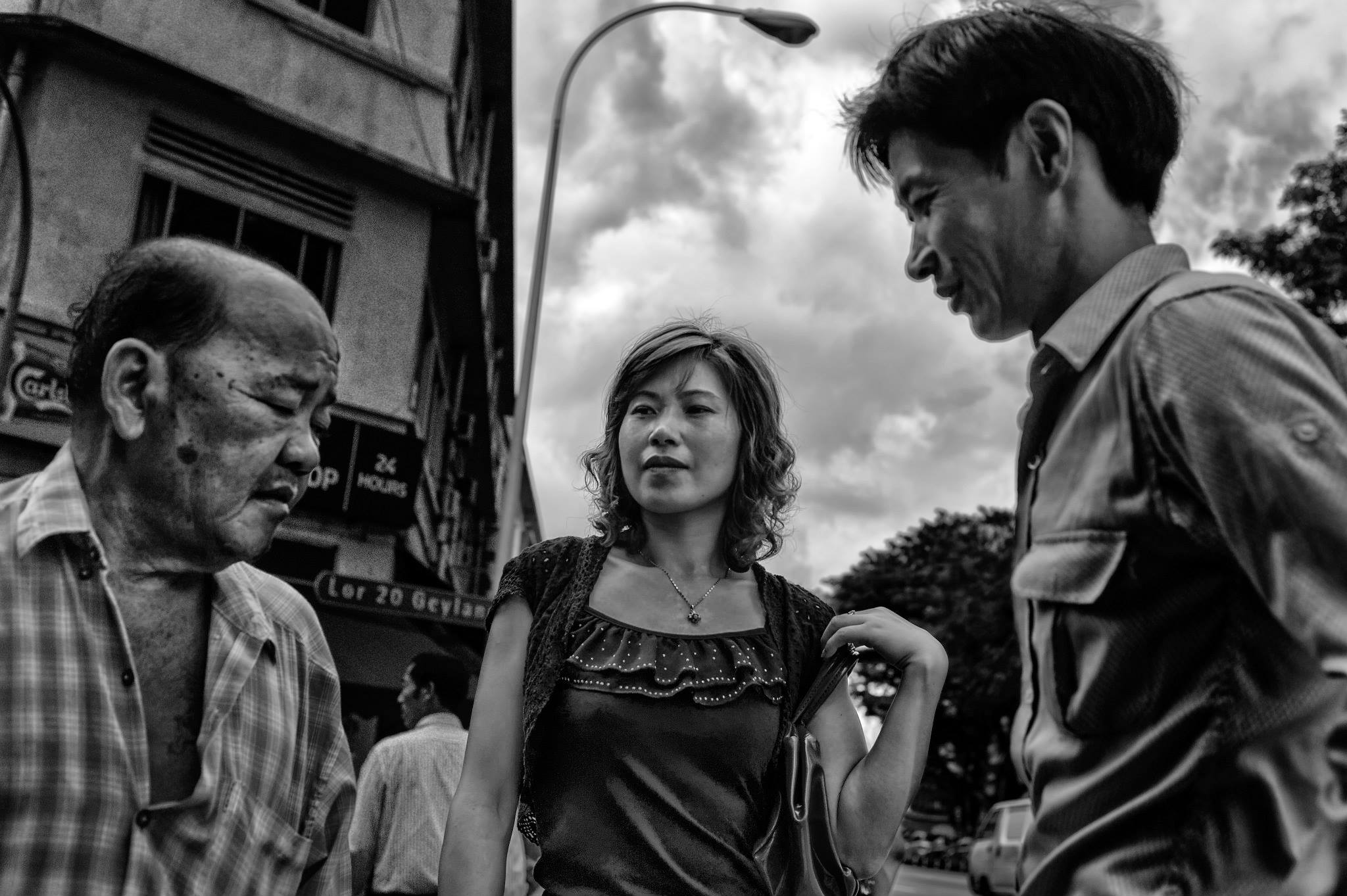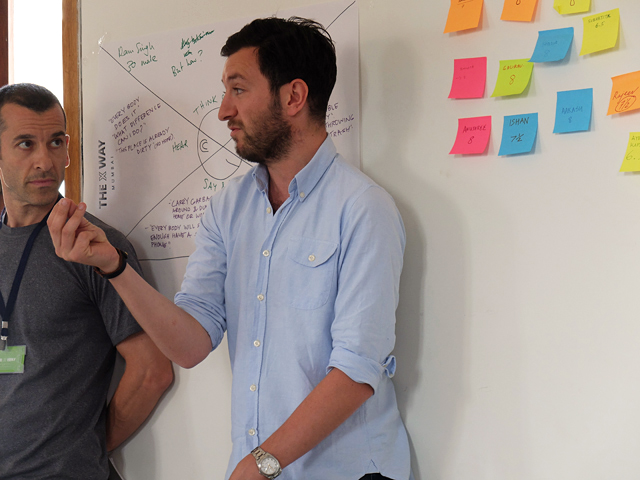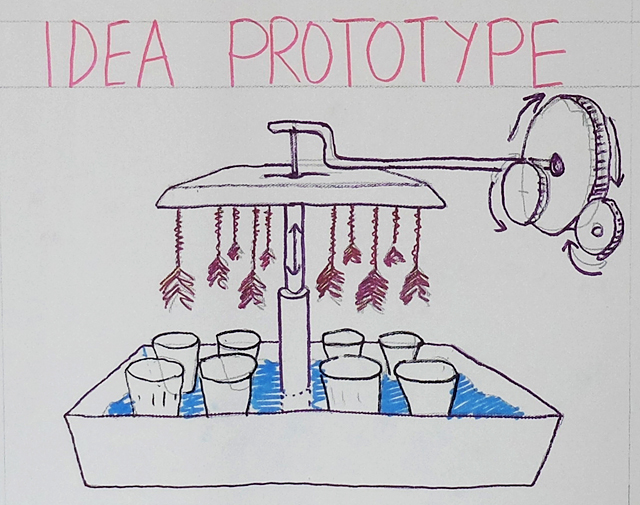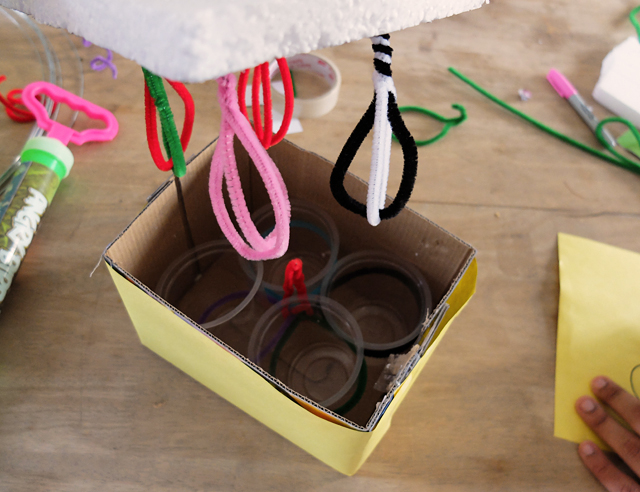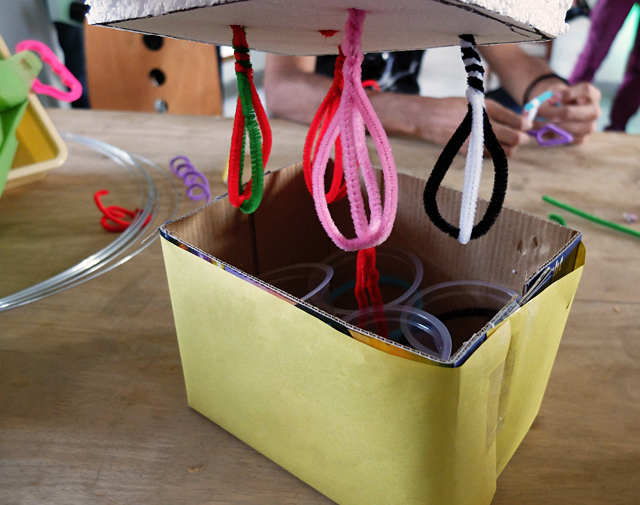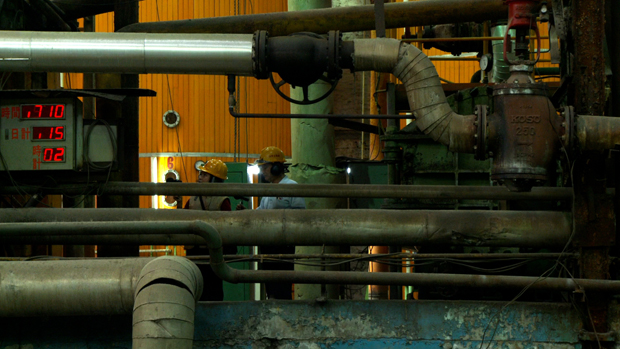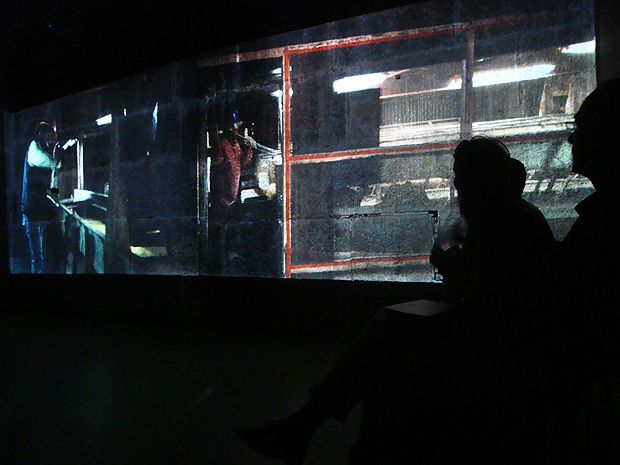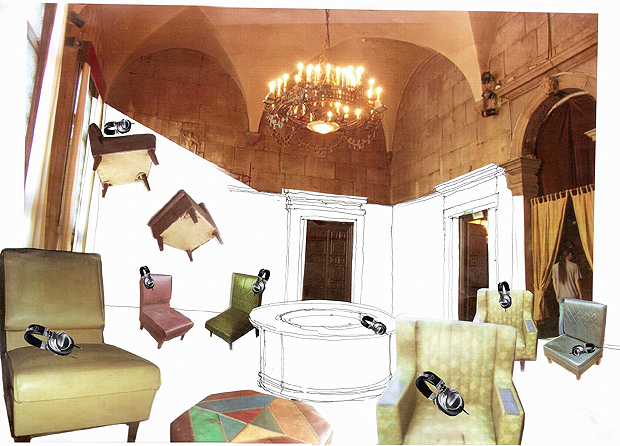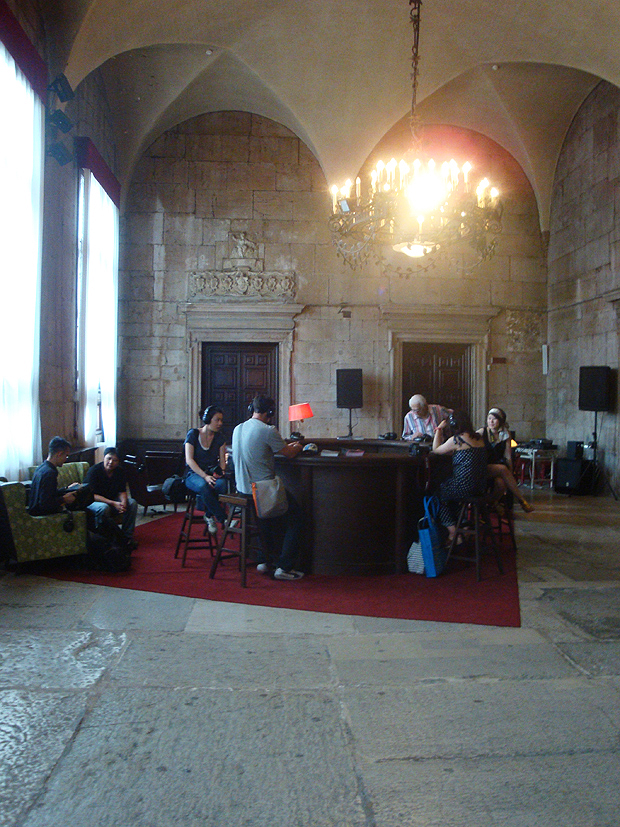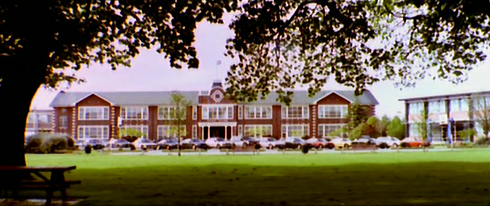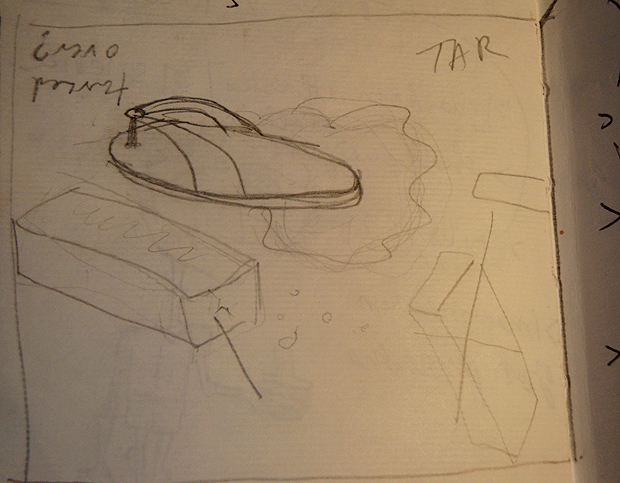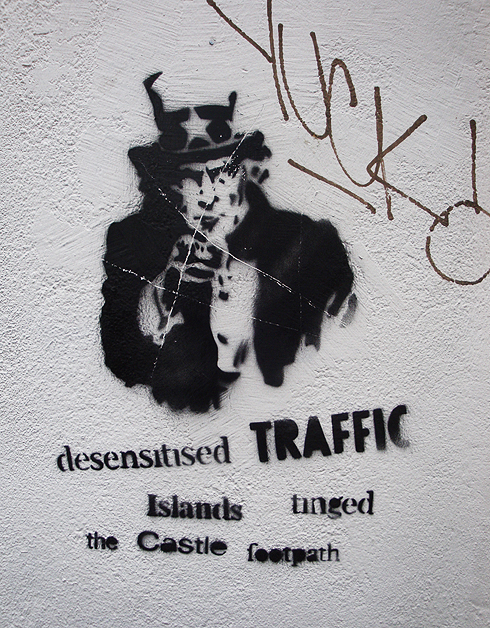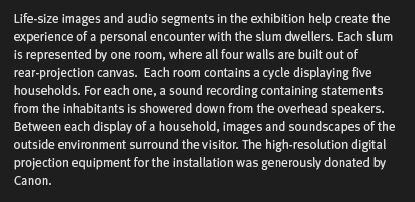Luciano Checco
Fascinating photographs by Luciano Checco of the 'other' side of Singapore.
Fascinating street photographs by Luciano Checco of the 'other' side of Singapore. Check out the entire album here.
Creating the Jugaad Dishwasher, The X-Way
The X-Way was a 2 day workshop sponsored by Nokia and Microsoft that focused on ideas, strategies and discussion around improving Mumbai city. Ben & Andrew moderated the workshop, keeping it challenging as twenty creatives and innovators came together with many, many city ideas.
The X-Way was a 2 day workshop sponsored by Nokia and Microsoft that focused on ideas, strategies and discussion around improving Mumbai city. Ben & Andrew moderated the workshop, keeping it challenging as twenty creatives and innovators came together with many, many city ideas.
One of the interesting exercises was listing things we love and hate about Mumbai. It was heartening to see that the 'love' pile was so much bigger despite Mumbai's numerous faults.
When discussing Mumbai's numerous problems, traffic cannot be ignored. Everything to do with traffic and way-finding is contextual. Signage is missing in a lot of places. When pedestrians give directions, the meaning may be different depending on the tone of their voice, how they stand, hand gestures and language. Honking has varied meanings depending on frequency, tones, loudness and the length of each honk. The city is a hotbed of large scale issues and topics of interest.
My team eventually looked at pavement ownership as a microcosm of health and sanitation. How could we encourage and create value in a public space such as pavement. We were in posh areas of Mumbai, and even here we found street hawkers taking ownership of pavements (in a good way) keeping them clean and ensuring their part of the pavement was maintained. Eventually we focussed even further and came up to a sugarcane vendor. Could we come up with something to help him wash the glasses in his stall while he was busy doing a million other things like making the juice, serving and cashing. A lot of times hygiene and proper washing was way down in his priorities while multi-tasking.
The final concept after two days of guerrilla research and quick prototyping was the 'jugaad dishwasher' - a mechanically automated machine that washed glasses saving the vendor time and effort as he ran a one-man operation. The washer connects to the juice machine itself so it doesn't need electricity to run. Soap is optional here since most vendors do not use soap. Overall the 'jugaad dishwasher' concept could also work for other street hawkers, juice vendors and with a few upgrades could even save time in someone's kitchen.
Check out some photos of the prototype we made. The video below has a few shots of us talking to sugarcane vendors.
The rotating juicer translates into the up and down movement of the simple washer, which repeatedly rinses the glasses. The trough can be easily refilled and cleaned and occupies minimal space.
Post-Traumatic Urbanism
Cities like Mumbai and Beirut have developed in unstable uncertainty and in many ways are resilient survivors. They have adapted with 'redundant networks' and 'diversity and distribution' rather than 'centralized efficiency' which makes them flexible in the face of shocks to infrastructure (Lahoud, 2010).
Mumbai as a city has undergone several traumatic events in the past few years. Those in my direct memory and experience are the 26/11 attacks and the painfully recent 2011 bombings. Earlier I argued that despite these tragic events the city in essence remained the same. How does a city survive these traumatic events whether they are natural flash floods or terror attacks, and in what way does it change? Today people try to understand how cities survive and evolve through math and science. As a philosophy urbanism states that cities are vitally important to the progress of humanity. In his talk The Surprising Math of Cities and Corporations, West argues that cities are both the solution and the problem, underlining their bipolarity.
And the tsunami of problems that we feel we're facing in terms of sustainability questions, are actually a reflection of the exponential increase in urbanization across the planet... However, cities,despite having this negative aspect to them, are also the solution. Because cities are the vacuum cleaners and the magnets that have sucked up creative people, creating ideas, innovation, wealth and so on. So we have this kind of dual nature. (Geoffrey West, 2011)
West explains why cities are so successful when he says 'You could drop an atom bomb on a city, and 30 years later it's surviving. Very few cities fail.' Mumbai as a city has survived several traumatic events over the past two hundred years, though nothing on such a catastrophic level. It is an ancient place that has been ruled by a succession of invaders. There is even evidence that suggest that the islands have been colonized by humans since the Stone Age. Each event in this recorded and unrecorded past have changed the landscape and its people, but I am most interested in its recent traumas.
So cities are extremely successful, bipolar creatures. But how do traumas affect them? Philosopher and critical theorist Andrew Benjamin says that 'trauma involves a more complex sense of place.' He proposes that the city contains forgotten and repressed settings that are beyond memory but always present, creating an 'estrangement' and sense of the 'unaccustomed' when such events return.
The term 'post-traumatic' refers to the evidence of the aftermath - the remains of an event that are missing. The spaces around this blind spot record the impression of the event like a scar. (Lahoud, 2010. p.19).
Cities like Mumbai and Beirut have developed in unstable uncertainty and in many ways are resilient survivors. They have adapted with 'redundant networks' and 'diversity and distribution' rather than 'centralized efficiency' which makes them flexible in the face of shocks to infrastructure (Lahoud, 2010). When it comes to events like the most recent bomb attack in 2011, the city picked up the pieces and went on the next day as if nothing had happened. Local trains continued to run. The event was given its significant narrative by the media and the places that were bombed were cleared up. Memories and the gaps created by such violence will always remain an intrinsic part of the city's architecture. But it is Mumbai's impenetrable resilience in the face of such catastrophes that fascinates me. Events such as 9/11 in a first world country completely derailed the city, but in Mumbai it was in many ways business as usual. But forgetting like we do in Mumbai does not erase the hurt.
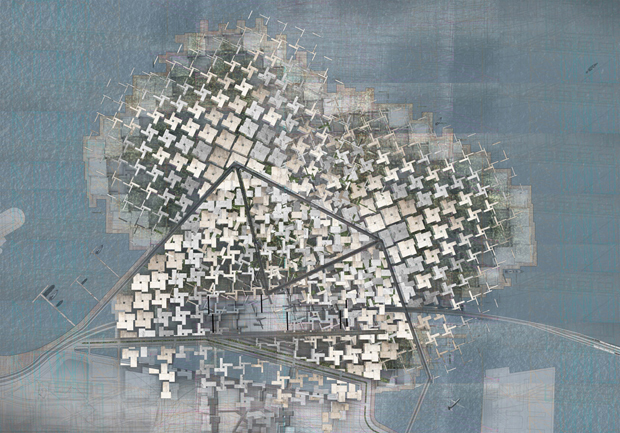 The Diversity Machine and Resilient Network, 2009. Social Transformation Studio. Martin abbot, Georgia Abbot, Clare Johnston, Joshua Lynch and Alexandra Wright.
The Diversity Machine and Resilient Network, 2009. Social Transformation Studio. Martin abbot, Georgia Abbot, Clare Johnston, Joshua Lynch and Alexandra Wright.
Anthony Burke says that the reason cities are so difficult to predict is that they are very complex systems 'growing at the edge of chaos.' Even small events can lead to avalanche-like conditions because both natural and human-made catastrophes display a self-organizing criticality or the:
...tendency of large systems with many components to evolve into a poised, `critical' state, way out of balance, where minor disturbances may lead to events, called avalanches, of all sizes. Most of the changes take place through catastrophic events rather than by following a smooth gradual path. The evolution to this very delicate state occurs without design from any outside agent. The state is established solely because of the dynamical interactions among individual elements of the system: the critical state is self-organized. Self-organized criticality is so far the only known general mechanism to generate complexity. (Per Bak, 1997, p.1).
The idea that a city is on the verge of chaos is not far from many narratives in western popular culture. The accepted line is that just one push is enough to bring the whole system crumbling down. However the theory above is not as simple as that, these systems are large and therefore extremely difficult to destroy completely. Its heartening to see that even human cities are in the end, part of nature, and follow patterns similar to natural phenomenon such as weather.
Although there are no definitive answers to what post-traumatic urbanism is the term itself raises critical questions and discussion. An often quoted statistic today is that the urban world is larger than the rural world, which underlines the importance of trying to understand urban trauma and its effect on the city and its people. In my journey to capture the essence of Mumbai, to explore unexpressed feelings of conflict created by repressed events and resolve my own perceptions and experience; it is this complexity which is central to understanding my art.
Reference: Benjamin, A. (2010). Trauma within the Walls: Notes towards a philosophy of the city. Architectural Design. Vol. 80. No.5. pp.24-31. Burke, A. (2010). The Urban Complex: Scalar probabilities and Urban Computation. Architectural Design. Vol. 80. No.5. pp.87-91. Lahoud, A. (2010). Post Traumatic Urbanism. Architectural Design. Vol. 80. No.5. pp.14-23. Per Bak. (1996). How Nature Works: The Science of Self-Organised Criticality. Copernicus Press: New York. West, G. (2011). The Surprising Math of Cities and Corporations. [online]. Available from http://www.ted.com/talks/geoffrey_west_the_surprising_math_of_cities_and_corporations.html [Accessed 2nd Aug. 2011].
Dayanita Singh
I am especially interested in her attempts to express her own visions of a place or city, opposing the singular story people usually expect about India, that of 'sensational catastrophes and human failures'
Phil mentioned Singh in connection to my work on Mumbai because of her series of photographs titled Dream Villa. Her landscape images of Mumbai resonate with the kind of video I'm using for my installation. I am especially interested in her attempts to express her own visions of a place or city, opposing the singular story people usually expect about India, that of 'sensational catastrophes and human failures' (Cotter, H. 2005). Dream Villa 11. 2008. Dayanita Singh [Image Source]
House of Love 2010. Dayanita Singh. [Image Source].
Reference: Cotter, H. 2005. Objects of Repose and Remembrance. New York Times. [online]. Available from: http://www.nytimes.com/2005/03/30/arts/design/30cott.html?ex=1172638800&en=840b508f152bce9e&ei=5070 Date Accessed: 21st July 2011.
Degen, N. 2008. Dayanita Singh. Frieze Magazine. [online]. Available from: http://www.frieze.com/shows/review/dayanita_singh/. Accessed: 21st July 2011.
Dayanita Singh: House of Love. La Lettre. [online]. Available from: http://lalettredelaphotographie.com/entries/dayanita-singh-house-of-love. Date Accessed: 7th August 2011.
Danger of a Single Story
This brilliant TED video by novelist Chimamanda Adichie articulates what I often have to say about Mumbai while here in UK. Namely, yes there is poverty and yes we have slums - but these are proud people who are more than just the anonymous poor.
This brilliant TED video by novelist Chimamanda Adichie articulates what I often have to say about Mumbai while here in UK. Namely, yes there is poverty and yes we have slums - but these are proud people who are more than just the anonymous poor. They don't want your useless pity. When I make art about Mumbai I often have to defend my work and my position to outsiders because it is not the typical vision of what people imagine Mumbai to be, which is terrible disparity and nothing else. She is also quick to point out however, that all of us have at one point or the other indulged in a 'single story.' Whats important is to be aware of it and avoid it as much as possible.
Site-Specific Art
In his book Eyes of the Skin, Pallasmaa talks at great length about the beauty of human perception and how the senses interact with each other to form experience. He emphasizes the importance of a sense experience as a whole. He says there is a bias to the eye in the architectural practice because people are focussed on how a building looks rather than how a body can move within it or how it feels. When it comes to the perception of places he discusses the importance of emotion, memory, imagination and fantasy.
During my research into place-making in phase two I briefly discussed the rigidity of a panoramic city view and my attempts to break it by framing unfamiliar cityscapes, using shadows and through collaboration. The book is relevant to my studies because it discusses creating place, the transitive nature of site, framing and virtual and 'real' spaces. The author describes monuments as loci's of power and authority (Kaye, 2000) in his chapter on Performing the City. This underlines the rigidity of the panorama since monuments are an iconic part of them. A relevant example is Mumbai's famous Nariman Point which is named after a historical Congress party leader and contains Indian and international financial institutions and government buildings such as CBI, RBI, Mittals, Birla's, JP Morgan, Merrill Lynch, Vidhan Sabha etc.
Monumentality […] always embodies and imposes a clearly intelligible message. It says what it wishes to say - yet it hides a good deal more: being political, military and ultimately fascist in character" (Lefebvre, 1991 cited in Kaye, 2000, p. 34).
He also discusses the relation between the body and the city or built environment and the body and the space, which in this case is the installation space in artist Wodiczko's work. A completely artificial and constructed installation is also a built environment. People interact with the architecture of the city, and similarly the audience interacts with the architecture of installation. The artist says that 'Our position in society is structured through bodily experience with architecture' (Wodiczko, 1992 cited in Kaye, 2000, p. 38).
In the installation test below, the audience directly affects an abstracted view of the city. In this constructed space people can directly change and affect an image of the architecture, making it fluid and interchangeable.
The author says 'where the site functions as a text perpetually in the process of being written and being read, then the site-specific work's very attempt to establish its place will be subject to the process of slippage, deferral and indeterminacy in which its signs are constituted' (Kaye, 2000, p. 183).
Further reading lead me to Merleau-Ponty's theories of phenomenology and perception where he discusses the essence of perception and experience. He says that we cannot separate our minds and bodies from our perception of the world, or in other words that we are 'condemned to meaning' (Merleau-Ponty, 1962, p. xxii). In his book the Phenomenology of Perception he discusses the relationship between reflective and unreflective experience, psychological and physiological aspects of perception, and consciousness as a process that includes feeling and reasoning.
We must not, therefore, wonder whether we really perceive a world, we must instead say: the world is what we perceive. (Merleau-Ponty, 1962, xviii).
In his book Eyes of the Skin, Pallasmaa talks at great length about the beauty of human perception and how the senses interact with each other to form experience. He emphasizes the importance of a sense experience as a whole. He says there is a bias to the eye in the architectural practice because people are focussed on how a building looks rather than how a body can move within it or how it feels. When it comes to the perception of places he discusses the importance of emotion, memory, imagination and fantasy:
We have an innate capacity for remembering and imagining places. Perception, memory and imagination are in constant interaction; the domain of presence fuses into images of memory and fantasy. We keep constructing an immense city of evocation and remembrance, and all the cities we have visited are precincts in this metropolis of the mind. (Pallasmaa, 2005, p.67).
In my attempts to create a feeling of conflict within the city, a subtle realization of the bipolarity within Mumbai, the result was a space that could not be expressed as a still image. Not could it be expressed by only video. By adding a third dimension of time and motion, where the audience themselves make the image change and break the city is read as something in constant flux.
I know myself only in my inherence in time and in the world, that is, I know myself only in ambiguity. (Merleau-Ponty, 1962, p.402).
Reference: Kaye, N. 2000. Site-Specific Art: Performance, Place and Documentation. Routledge: London Merleau-Ponty. 1962. Phenomenology of Perception. Routledge: London. Pallasmaa, J. (2005). Eyes of the Skin: Architecture and the Senses. John Wiley & Sons: UK. View Wodiczko's Bio & Work in detail.
The Heard and Unheard
'By constructing an "architectural music-space...made possible by the microphone," Music While We Work explores how artistic practice can intervence in the social space of labor production at the intersection of history and everyday life.'
At the Taiwan pavilion, artists' Hong-Kai Wang and Yi-Hsien Su created soundscapes that transformed the way I look at how sound can be used in installation work. Hong-Kai Wang's work especially connected with my attempts to use sound to comment on Mumbai's atmosphere and culture. She says,
'By constructing an "architectural music-space...made possible by the microphone," Music While We Work explores how artistic practice can intervene in the social space of labor production at the intersection of history and everyday life.'
Hong-Kai WANG. Music While We Work. Huwei, Yunlin, Taiwan. 2011. Audio and video installation. Video still by Yann Tonnar. Courtesy Hong-Kai WANG.Taiwan pavilion at Venice Biennale 2011. [Press Release].
Music While We Work by Hong-Kai Wang. (2011). Installation photo by Aditi Kulkarni. Taiwan pavilion at Venice Biennale 2011.
In addition to these two artists the sound bar had a wide variety of independent music and sound compositions from Taiwan to sample and enjoy.
Sound Library Bar design by Kuo-Chang Liu. Taiwan Pavilion. Venice Biennale 2011. [Press Release].
Sound bar library at Taiwan pavilion. Photo by Aditi Kulkarni. Venice Biennale 2011.
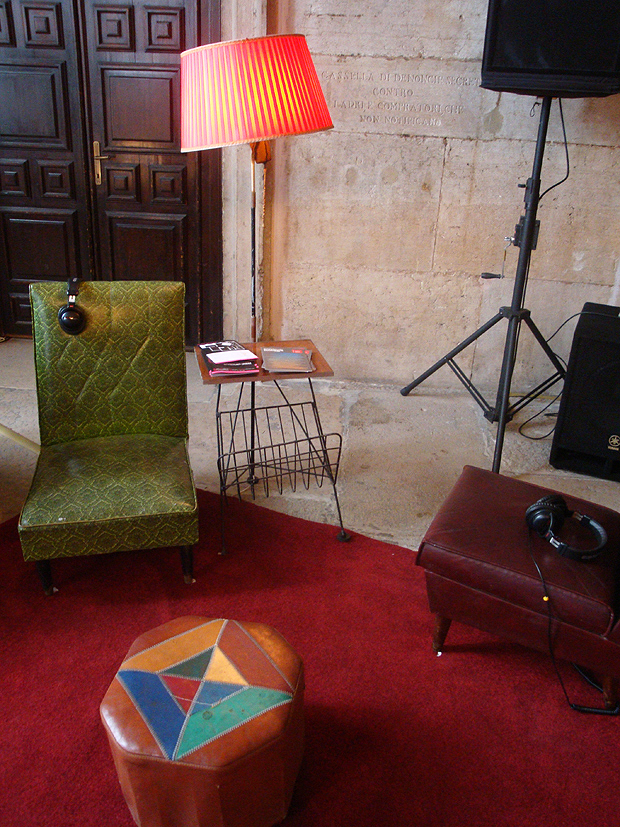 Sound bar library at Taiwan pavilion. Photo by Aditi Kulkarni. Venice Biennale 2011.
Sound bar library at Taiwan pavilion. Photo by Aditi Kulkarni. Venice Biennale 2011.
'I think the most important and uninvestigated architectural music-space of our time is the imaginary space made possible by the microphone...a space that does not exist in any form in any place in the everyday world.' (Ashley,r. 2009 cited in Hong-Kai Wang, 2011. p.17)
In her artist statement Hong Kai Wang quotes American avante-garde composer Robert Ashley, and I found these lines especially relevant. My aim is to transport the audience to Mumbai, my hometown and I agree that this relation between sound and essence of place, though immensely powerful is often ignored.
Reference: Hong-Kai Wang. (2011). Music While We Work. Venice: Palazzo Delle Prigioni. Notes: The Heard and the Unheard: Soundscape Taiwan. The Exhibition of theTaipei Fine Arts Museum of Taiwan. The Taipei Fine Arts Museum of Taiwan. Curator: Amy Cheng. Artists: Hong-Kai Wang Yu-Hsien Su.
Laundry Room City
![]() Participants: Michael Moore, Samantha Else, Baran Saragul, Rina Miyake, Ben O'Shea, Taro Morimoto, Yi Lu, Tanya and me.
Photos by Samantha Else and me. Paper-mache dolls and houses by Yi Lu. Video and installation set-up by Aditi Kulkarni.
Participants: Michael Moore, Samantha Else, Baran Saragul, Rina Miyake, Ben O'Shea, Taro Morimoto, Yi Lu, Tanya and me.
Photos by Samantha Else and me. Paper-mache dolls and houses by Yi Lu. Video and installation set-up by Aditi Kulkarni.
Since I live in a building full of artists, I decided to invite everyone to one of my spontaneous experiments with the Mumbai videos. Using objects I found in the laundry room such as pieces of thermocol, cardboard boxes, chairs, clothespins and piles of yellow pages I created a crowded, urban space. No sound was used since I couldn't find speakers. After the first thirty minutes of discussion and feedback, people started adding and subtracting to the work, literally "playing" with the objects I had collected and even adding their own. Overall it was exciting since I felt it was relevant to the process of literally "building" a city which is unplanned and crowded like Mumbai, filled with so many different people. Eventually Yi Lu added her own work to the installation; fantasy objects such as houses and dolls made of paper-mache.
This event lead to the collaborative work Tobari no Akari by Taro Morimoto, Yi Lu and me. It also formed the base for my later experimentation with City Memories. Sam and Michael came up with the suggestion to use lego, which lead to Lego city #1.
More on Mumbai Lights
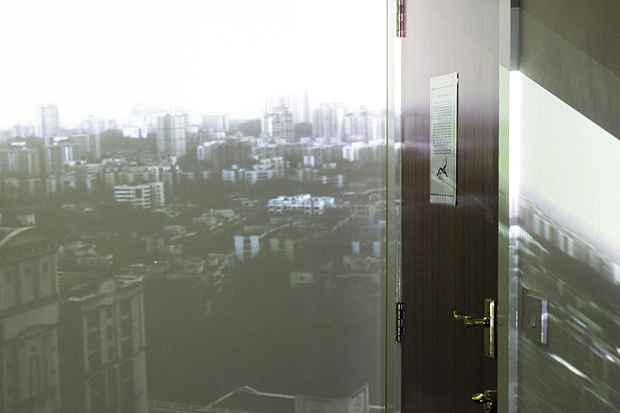
 ^Texture: Projecting on the floor carpet.
^Texture: Projecting on the floor carpet.
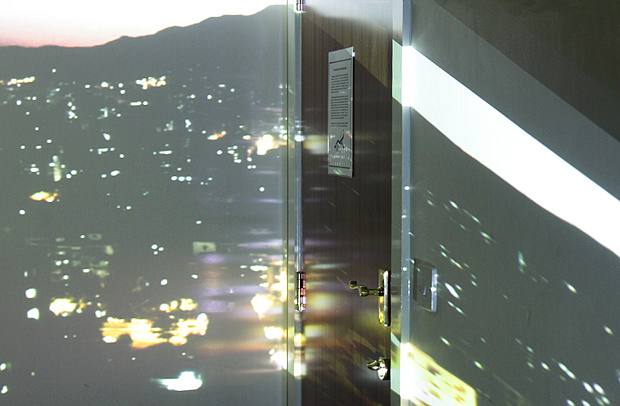 ^Distorted night video on the same door.
^Distorted night video on the same door.
 ^Texture: Regular projector produces visible lines and pixels that cover the wall.
^Texture: Regular projector produces visible lines and pixels that cover the wall.
This is a series of experiments on how Mumbai city lights and sound interact with familiar spaces around me. Earlier I used overlapping projections and shadows to express a conflicting bipolarity within Mumbai. As I attempt to integrate relevant space and sound into the experience, location is one of the most important factors that come into play. One option is to use the projections and video in a suitable outdoor space, and the other is to use a place personal and familiar to me, referencing my memories of the city and my identity as a Mumbaikar. Here I've experiments on the walls, ceiling and floor carpet, observing the effects of the night videos and day videos on various coloured surfaces and corners. The results encouraged me to try more spontaneous variations, rather than make just one well-planned installation.
Place-Making
Notes on urban memory, place-making and its relation to the interpretation of the city in contemporary art and architecture.
During my tutorial with Ronnie Inglis we spoke about the meaning behind the autobiographical trend in my work and further topics of study, especially in relation to place-making. We discussed my previous areas of interest such as the city and fantasy, collective versus personal urban memories, place-making in relation to site-specific art, use of the shadow, and representing extremes. He directed me towards the book History of the Shadow which greatly influenced my work in the following weeks. The topic of Genius loci is relevant because I am interested in shooting my projections in outdoor locations. According to Thompson (2003, p.67) 'the Romans believed that places, like people, had inner spirits that determined their essences,' and similarly I was interested in this essence of Mumbai. Thompson also mentions that for genius loci to be useful rather than a mere magical notion it should be a combination of 'character, local distinctiveness and ecosystem' (2003, p.69). This lead to the idea of representing the city as a fictionalized creation, in the same way a writer creates a fictional character.
And a thing's character changes and develops over time. This can happen slowly or through abrupt events. The reading made me realize that Mumbai has not developed slowly or without trauma. It has grown in bursts and starts. Several traumatic events such as the '93 bombings and the more recent 26/11 Taliban attack have affected the city. We could argue however, that despite these severe shocks the essence of the city remains the same. According to Norberg-Schulz (cited in Thompson, 2003, p.70) "places can change, sometimes rapidly, but this does not necessarily mean that the genius loci changes or gets lost."
An excellent example of the genius loci being kept intact by an architect is the above landscape park Landschaftspark Duisburg-Nord by Peter Latz. The place was 'traumatized by industrialization and deindustrialization' and the architect built upon 'its existing character, creating fern gardens in ore bunkers and making their mass concrete walls into facilities for rock climbers' (Thompson, 2003, p.72). This connects to my idea of using appropriate objects, materials and sites that are relevant to the trauma and violence of the city.
^Cotton 56, Polyester 84 is a play about how the failed Mumbai Mills are getting converted into malls and entertainment complexes. Citizen's groups demand that the land should be converted into open parks and low cost housing, but slowly and surely all mill land will be sold to builders (Shanbag, 2006).
^Another abandoned Mumbai Mill.
As sites these are beautiful and tragic places that express this violent and crushing conflict between the here and the elsewhere, the undesirable and the desired. I can only pursue this direction further once I am back in India. At the same time it brings me to question my interest in these places, since my knowledge of these events is purely historical, through media reports and local people's opinions. At this point in my practice I would prefer to express issues and places that I have personally and directly experienced.
Another important aspect of place is memory, which is in turn closely related to history. Historical buildings such as the mills compounds and their replacements are part of a general history of the city. Individual memories have a completely different flavour. In the book City of Collective Memory the author underlines this difference by proposing that history and memory are bipolar attributes because history is linear and memory non-linear (Boyer, 2001, p.67). Collective memory is 'a current of continuous thought still moving in the present, still part of a group's active life, and these memories are multiple and dispersed, spectacular and ephemeral, not recollected and written down in one unified story' (Boyer, p.67).
Another fascinating point is that this urban memory is 'an antimuseum and not localizable' (Boyer, p.68). This means that my earlier work using popular landscapes and landmarks was a reference to history, a revision of a recognizable historical reality. It is also a reference to memory since I have taken various historical elements and placed them in a contemporary context. Now that I am using scenes that are not famous or instantly recognizable such as the Thane landscape I am removing "historical" elements from the work.
The next topic is framing. We frame the place or city 'by travel, in the theater, at the museum, from the cinema, through its architectural compositions' (Boyer, p.70). The panorama as a framed image is questionable - the city of the panorama is criticized for its 'rational scientific methods,' 'describable pasts' and 'predictable futures' (Boyer, p.68). The author criticizes common recycled views of the city saying 'We have learned to gaze upon the city as artifact through illustrated portfolios and architectural guidebooks that have their own procedures for characterizing place and tradition' (Boyer, p.69).
And finally I'll quote Victor Burgin (1996, p.7) who says that 'we cannot know a 'city', only those of its places we come to frequent.'
Reference
Boyer, C (2001). The City of Collective Memory, Its Historical Imagery and Architectural Entertainments. MIT Press.
Burgin, V. (1996). Some Cities. London: Reaktion Books Ltd.
Thompson, I. (2003). What use is the genius loci? In: Menin, S.(eds). Constructing Place, Mind and Matter. London: Routledge. pp.66-76.
Pile, S. and Thrift, N. (2000). City A-Z. London: Routledge
Wikipedia. (2011). Urbanism [online] Available from http://en.wikipedia.org/wiki/Urbanism. [Accessed 23rd April 2011].
Modern Drawings
Drawings of life in the city, and abstract dream cities. From the exhibition Picasso to Julie Mehretu, modern drawings from the British Museum collection [7th Oct 2010 to 25th April 2011].
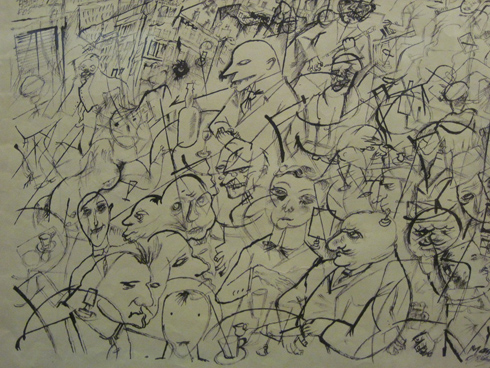 People in a Cafe, 1917 by George Grosz. [Image Source]
People in a Cafe, 1917 by George Grosz. [Image Source]
 Dreamland Tower, Coney Island 1912 by David Milne (1882-1953). [Image Source]
Dreamland Tower, Coney Island 1912 by David Milne (1882-1953). [Image Source]
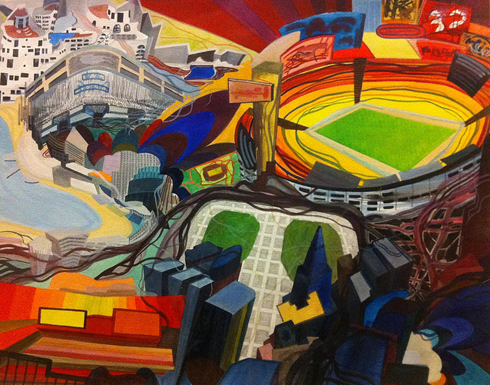 Untitled (Pacific No. 32, weekend), 1998 by Franz Ackermann. [Image Source]
Untitled (Pacific No. 32, weekend), 1998 by Franz Ackermann. [Image Source]
 Untitled (City Abstraction) 1912 by Abraham Walkowitz. [Image Source]
Untitled (City Abstraction) 1912 by Abraham Walkowitz. [Image Source]
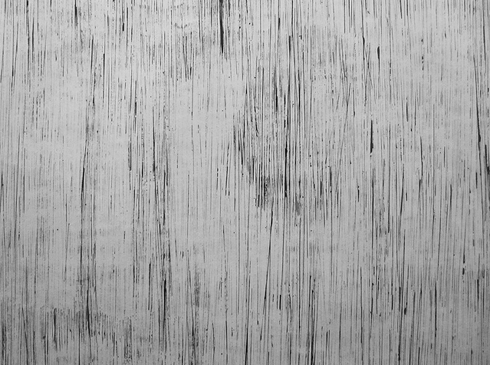 Vertical Lines 1953 by Kazuro Nakamura. [Image Source]
Vertical Lines 1953 by Kazuro Nakamura. [Image Source]
 Untitled by Lawrence Weiner (born 1942) [Image Source]
Untitled by Lawrence Weiner (born 1942) [Image Source]
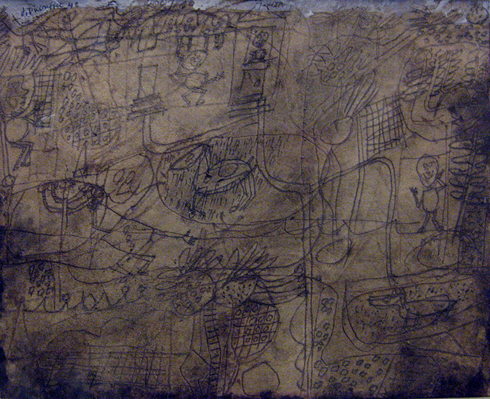 Grotesque Landscape in Yellow 1949 by Jean Dubaffet (1401-85) Pen and ink on yellow watercolour. [Image Source]
Grotesque Landscape in Yellow 1949 by Jean Dubaffet (1401-85) Pen and ink on yellow watercolour. [Image Source]
Update 4th May: I've only included work that is relevant to my project on representing the atmosphere of the city. In my journey towards representing the violence between the fantasy and the real within Mumbai, I've noticed a trend towards abstraction especially with the increasing use of shadows and reflections within the installation. These drawings capture this urban feeling in their own individual expressionist ways.
Dark Stuff
I stumbled on the work Dark Stuff (2008) while looking at random postcards being sold at the British Museum in London. Tim Noble and Sue Webster had created an impressive image inspired by Egyptian mummies, and it motivated me to look for more of their work. Then I found Sunset in Manhattan (2003).
Dark Stuff, 2008 by Tim Noble and Sue Webster 189 mummified animals (67 field mice, 5 adult rats, 42 juvenile rats, 44 garden shrews, 1 fox, 1 squirrel, 1 weasel, 13 carrion crows, 7 jackdaws, 1 blackbird, 1 sparrow, 1 robin, 1 toad, 1 gecko, 3 garden snail shells), glue, metal stands, light projector [Visit Image Source]
Sunset over Manhattan, 2003 Cigarette packets, tin cans shot by air gun pellets, wooden bench, light projector 110 x 31 x 75 cm (431/3 x 121/4 x 291/2 in) [Visit Image Source]
Here the use of rubbish combined with light and shadow creates a city that is recognizable as Manhattan, and at the same time makes an important comment about the place itself. At this point in my project I explored the use of objects in my installations and what kind of objects would be relevant to the concept of the fantastical and the real.
Genius Loci
In phase one I succeeded in defining my area of study, learning about projecting video, building installations, and the limitations involved. Phase two is about capturing a "feeling" of Mumbai. But what is this feeling, this intangible "sense of place," and how can I create a space that communicates it effectively. The city is a multi-layered, complex and rich experience. No one has identical perceptions of something that is so much in flux, so huge in scale. At the same time there is an underlying recognition of its flavour, a distinctive personality that can be called its Genius Loci. In trying to pinpoint this atmosphere of Mumbai, something which is intrinsic in my memories of the city, and which all Mumbaikars are familiar with, I questioned my original plan of building a 360 panorama in a closed studio space.
An outdoor location is one of the ways I plan to solve this riddle. Although it is technically difficult to build an installation outside a controlled studio set-up, I am of the opinion that the right place can physically represent the city, and communicate a lot more than well-edited video or sound ever could.
Place-making is discussed in detail here.
Reference
Menin, S. (2003). Constructing Place Mind and Matter. London: Routledge.
Projecting on Textures
Stumbling on the photograph below inspired me to explore projections on outdoor urban surfaces such as cement. The massive pillars give shape and personality to the projected paintings, changing their meaning.

"An extraordinary exhibition held in former bauxite mines in Provence. The hollow caves and pillars are used to project images, constantly changing and overlapping each other." Photo and description by dorsetlass @ flickr.
Mumbai Memories
After noticing the autobiographical trend in my work, I looked at my past posts on Mumbai. I've kept a partially anonymous life blog since 2009 and this became an important resource for me to remember what images and events I felt were important enough to blog about. The oldest posts about Mumbai are from August 2009. I've inserted some photographs from the life blog below:




Update April 27th: The image below is a sketch of a concept inspired by one of my school memories of Mumbai. While travelling on the school bus, we stopped to drop off a student and I noticed a single chappal on the tar road. There was a small pool of bright blood beneath it, and a few bricks lying around it. I wondered what happened, and guessed that there had been an accident recently, and these were the leftovers. It had definitely happened recently, but no crowd of onlookers remained and the traffic on the road avoided the single slipper and bricks easily. The idea is to recreate this memory as I remember it, with the blood being bright and overshadowing the rest of the details within the picture.
Circle of Confusion
One line from this article grabbed me: "It is impossible to grasp the city, one can only take a fragment of it."
 [Image Source] | Circle of Confusion by Joana Hadjithomas and Khalil Joreige | Photographic installation | Mirror, colour digital prints (3,000 pieces), ink inscriptions.
[Image Source] | Circle of Confusion by Joana Hadjithomas and Khalil Joreige | Photographic installation | Mirror, colour digital prints (3,000 pieces), ink inscriptions.
The work resonates with the aim of my project, as it seeks to represent the city of Beirut: how it's various and poorly documented conflicts have cut it into pieces, making it impossible to make a "true" picture of it, inviting the user to destroy the city by taking pieces off the board and scattering them, revealing a layer beneath. One of the questions brought up in the article is: "How does the viewer’s participation in this work, by removing and taking possession of a fragment of the city of Beirut, add to the meaning of Circle of Confusion?"
Similarly I can attempt to create a question for my work: How does the viewer's participation in this work, by revealing the hidden city of Mumbai in the viewer's shadows, add to the meaning of Mumbai+Bombay?
Abigail Reynolds
Abigail Reynolds: Layering and tessellation.

"The Universal Now: Relief sculptures using found photographs of the same place taken at different times." | Seventeen Gallery.
Reflection: Contemplating possibilities of adding layers to the already existing two layers of light as projections. It is possible that a third city panorama could exist behind the two already conceived, though it would be a print or a painting. It could also be a texture to add another layer of interactivity, that of touch.
Documentary: Changing face of Dharavi
Changing face of Dharavi, a documentary by journalism student Anisha Sharma. [youtube=http://www.youtube.com/watch?v=Tv8KC1bES50]
Brick Lane and London
My first real trip to London (I feel like such a tourist): it was only a day but we covered quite a bit, bravely braving the wind and rain to see as many art shows and galleries we could within a day. And we successfully covered at least ten, I think, popping in and out of the tube and walking and walking...

The Places We Live
The website is an interactive multimedia presentation of how people live in urban slums. Dharavi is represented with a combination of interactive space, photographs, stories, and sound. I saw this about one or two years ago, and now that I am finally in a position to spend time researching my city, I remember how much this spoke to me. It manages to articulate, to some extent, what it is like to live in the slums of Mumbai. Although I have never lived in a slum, the use of everyday street sound is haunting and familiar, nostalgic now that I am not living in Mumbai.
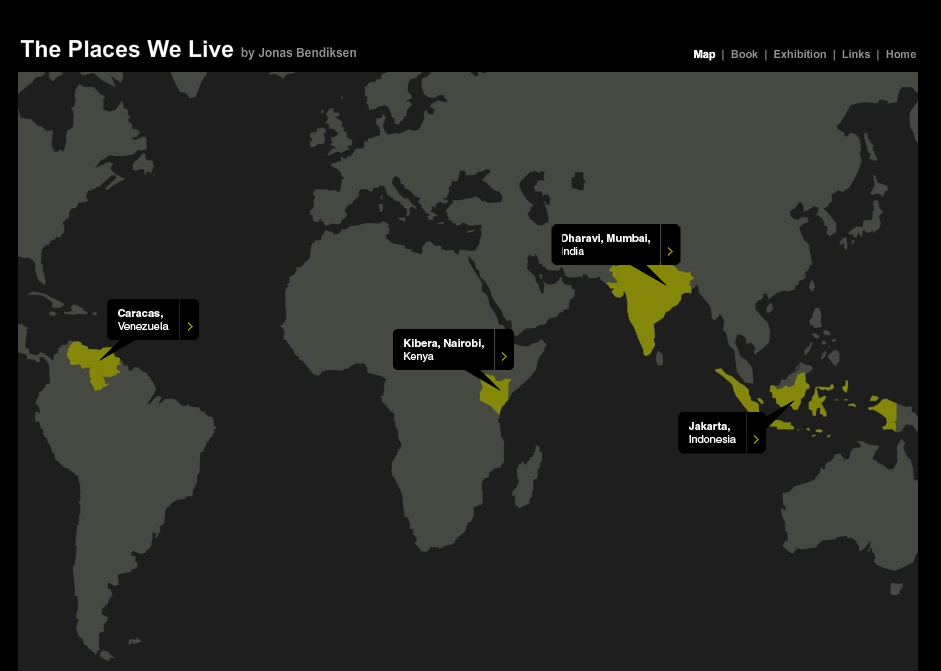
The exhibition and website are based on Jonas Bendikson's documentation of how people live in slums around the world The exhibition was first put up in 2008:








